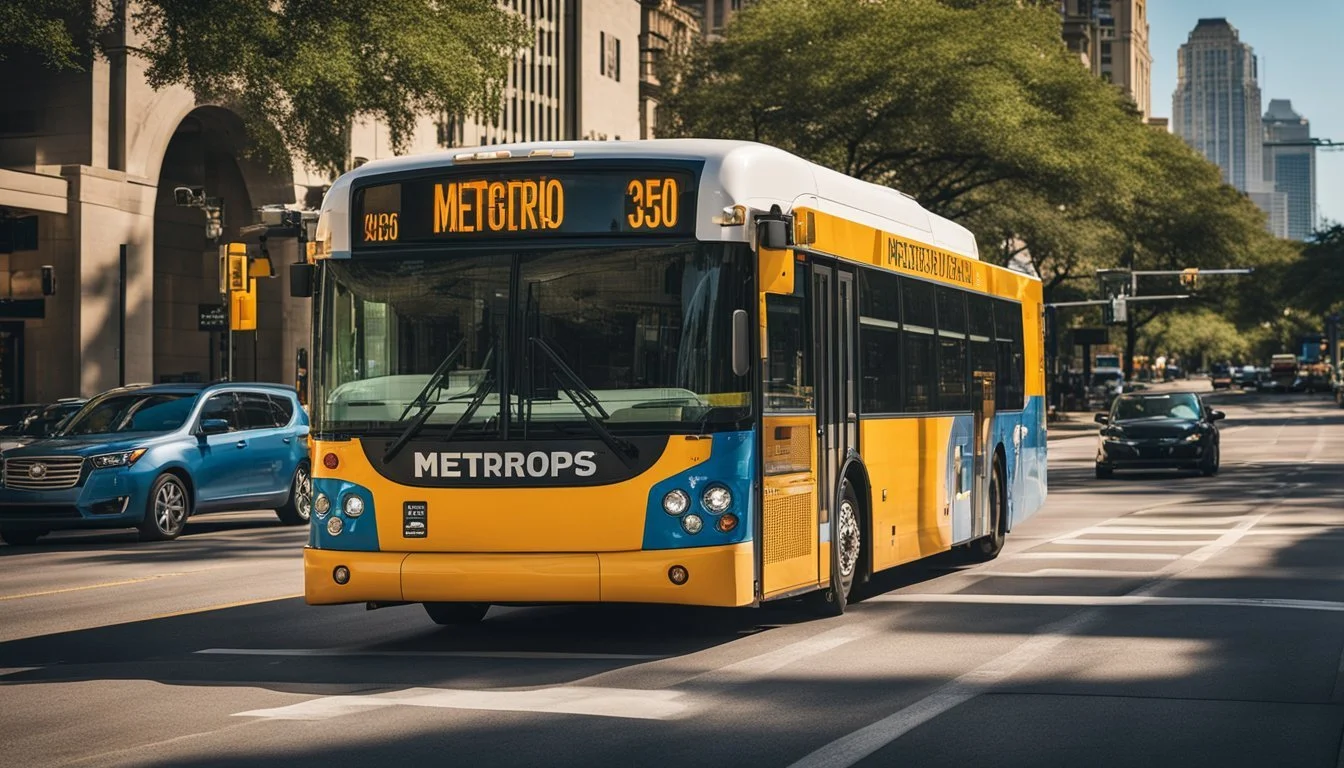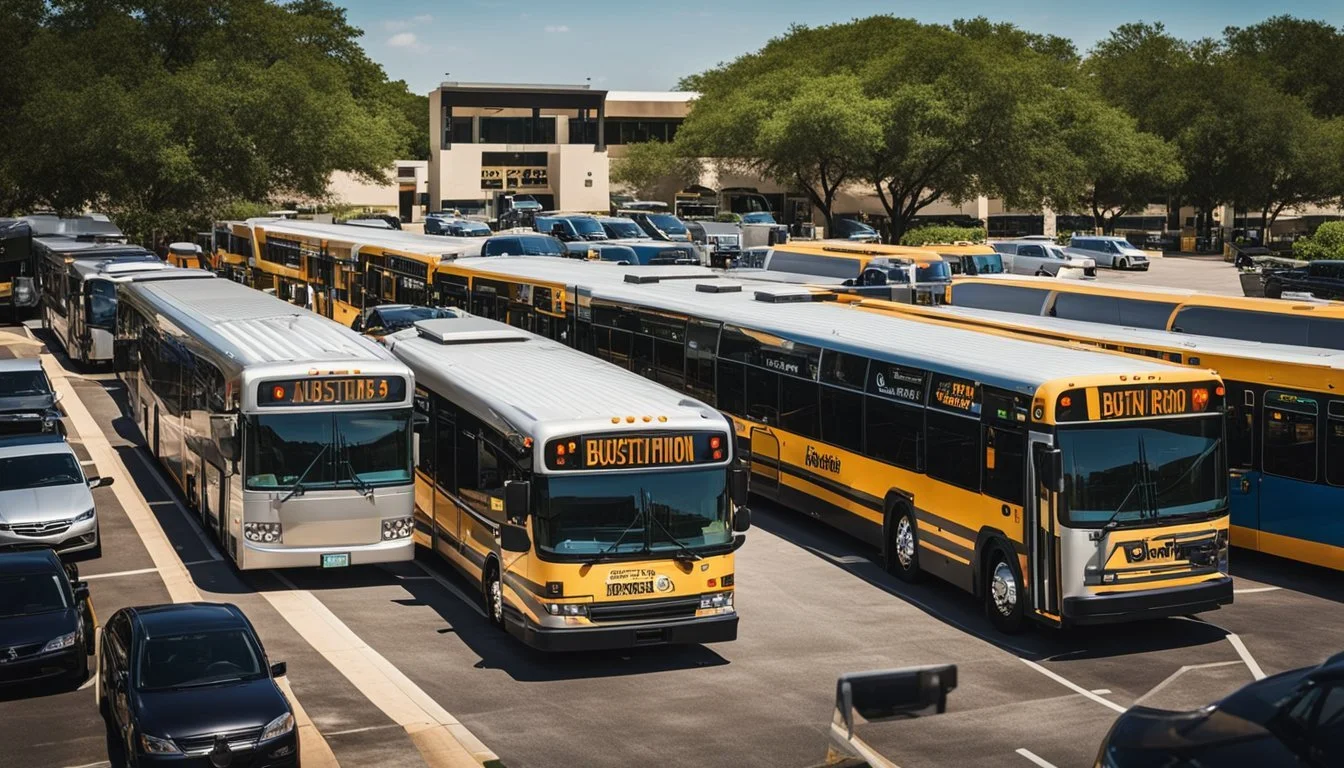10 Things to Know About Austin's Public Transportation
Essential Insights for Commuters
Navigating Austin’s public transportation system can seem complex at first glance, but it offers a variety of reliable options that cater to both locals and visitors. Capital Metro, also known as CapMetro, is the cornerstone of this network, providing essential services through buses, trains, and paratransit options.
Understanding these transportation choices can help make travel throughout the city more efficient and less stressful. Whether you're commuting to work, exploring downtown, or visiting the outskirts, Austin's public transit options are designed to accommodate a wide range of needs and schedules. By being informed about the available services, riders can significantly improve their overall transit experience.
1) Capital Metro System
Capital Metro, or CapMetro, is Austin's primary public transportation provider. It operates a comprehensive network of buses, trains, and pickup services that cater to various transportation needs.
The bus system, known as MetroBus, features multiple routes, including 14 high-frequency lines that ensure quick and efficient travel across the city. Riders can navigate these routes using the CapMetro App, which provides real-time information on schedules and destinations.
For rail services, CapMetro offers the MetroRail, connecting downtown Austin with the northern suburbs. This service is especially useful for commuters seeking an alternative to driving.
CapMetro also provides a valuable partnership with the city of Round Rock, extending its bus services to include three routes that connect to key areas like Howard Station and Tech Ridge.
For families, one notable benefit is that children 18 and younger ride for free, though those 10 and under must be accompanied by someone 12 or older. This makes CapMetro a family-friendly option for getting around the city.
In addition to regular services, CapMetro frequently adjusts its schedules for special events, like offering free rides after 5 p.m. for Independence Day fireworks, making it a convenient choice for attendees.
2) MetroRapid Buses
MetroRapid buses are a key component of Austin's public transportation network. These buses operate on high-frequency routes, ensuring minimal waiting time for passengers. During peak hours, MetroRapid buses run every 15 to 20 minutes, making them a convenient option for commuters.
One of the standout features of MetroRapid is its real-time data availability. Passengers can check live wait times on digital signage at each Rapid station or use the CapMetro App and Trip Planner. This ensures accurate and up-to-date information for all riders.
In addition to efficiency, MetroRapid buses are equipped with free Wi-Fi. This feature allows passengers to stay connected while traveling, whether they are catching up on work or browsing social media. It's especially useful for those with longer commutes.
MetroRapid runs through Austin's north-south corridor, which is a major thoroughfare for the city. This makes it a vital option for getting around, particularly during rush hours when traffic congestion is at its peak. Passengers often find that MetroRapid buses are faster than driving during these times.
The MetroRapid system's unique design enables it to avoid impeding traffic flow. When a bus stops, it impacts only other buses rather than creating a backlog of cars. This design helps maintain smoother traffic conditions along busy routes.
MetroRapid buses are also part of CapMetro's sustainability goals. With plans to achieve zero emissions for transit buses by 2035, these buses represent a step toward a more sustainable form of urban transit.
3) MetroRail Red Line
The MetroRail Red Line is the primary rail service operated by Capital Metro in Austin. Covering 32 miles, it connects downtown Austin with the city of Leander through Central and Northwest Austin. The line includes nine stations, including the newly opened McKalla Station, which serves the North Burnet area.
Trains on the Red Line typically run from early morning until late evening, with extended hours during weekends to accommodate events and nightlife. On weekdays, trains operate at a 30-minute frequency during peak hours, ensuring a reliable service for commuters.
Recent improvements have been part of Project Connect, including a $60 million investment into the McKalla Rail Station, which opened in February 2024. There are also ongoing capital projects like the Lakeline-Leander Double Tracking Project set to enhance service reliability.
Amenities available on the Red Line include free Wi-Fi and bike racks, making the commute more convenient for passengers. Real-time data is accessible through digital signs at all stations and the CapMetro app, ensuring that passengers can plan their journeys efficiently. These features combine to make the Red Line an integral part of Austin's public transportation network.
4) Downtown Station
Located in the heart of Austin, Downtown Station serves as a central hub for Capital Metro's transit network. Positioned near the Austin Convention Center, it is strategically placed to facilitate easy access to key areas within the city.
Downtown Station enhances connectivity by integrating various transportation options. Commuters can effortlessly switch between MetroRail, high-frequency buses, MetroBike, and electric scooters, making it highly versatile.
The design of Downtown Station prioritizes ease of transit. Its close proximity to major bus routes such as Route 2 on Cesar Chavez and Route 4 on 7th Street provides ample choices for travelers.
Its role extends beyond transit. The adjacent plaza enriches the surrounding public space, offering a welcoming environment for people to gather and linger. Improvements along the 32-mile MetroRail line further bolster the station's capacity to connect different regions.
For anyone navigating Austin, Downtown Station stands out as a pivotal point of access, linking various modes of transportation seamlessly. This makes it an essential part of the city's public transit infrastructure.
5) Bike Share Options
Austin offers several bike share options to cater to both residents and visitors looking for an efficient way to navigate the city.
The prominent MetroBike program, managed by CapMetro, is undergoing significant updates. Starting in July, it will feature a new fleet of 100% electric assist bikes and updated docking stations. This advancement aims to enhance the convenience and appeal of biking in Austin.
Austin B-cycle stands out as another key player in the bike-sharing landscape. It has a vast network of stations primarily concentrated in downtown Austin. The program's expansion plans include additional stations and improved services across various neighborhoods.
Community-focused initiatives are also a cornerstone of Austin's bike share programs. Efforts such as "B-Cycle For All" aim to ensure that low-income residents have equitable access to bike-sharing services. This program targets individuals making $25,000 or less annually, demonstrating a commitment to inclusivity.
These developments signal a promising future for bike-sharing in Austin, with increased accessibility and improved infrastructure to support the city's growing biking community.
6) Electric Scooters
Electric scooters have become a notable part of Austin's transportation landscape. These scooters offer a flexible and eco-friendly option for short-distance travel across the city. Since their introduction, e-scooters have been widely adopted, with over 7 million trips taken between March 2021 and December 2022.
Austin has implemented regulations to ensure the safe and orderly operation of electric scooters. As of April 2024, only Lime and Bird scooters are permitted to operate in the city. The number of e-scooters available has been reduced from 14,000 to 8,700 to address safety and accessibility concerns.
These scooters can often be found near clusters of businesses, restaurants, and entertainment venues, making them a convenient option for those traveling in busy areas. The abundance of e-scooters ensures that a ride is typically nearby when needed.
The city’s focus on regulation includes operational limits and precise guidelines to maintain rider safety and public accessibility. Both Lime and Bird have complied with these requirements, ensuring their scooters contribute positively to Austin's transport ecosystem.
7) CapMetro App
The CapMetro App significantly enhances the public transportation experience in Austin. It allows users to buy and manage passes for various services offered by Capital Metro. Paying for tickets on the go is now more convenient.
Riders can report suspicious or dangerous activities through the app. This feature helps maintain safety on board and at Capital Metro facilities. Users can easily find the option to report a public safety issue.
The app also provides real-time departure information. This helps passengers know exactly when their bus will arrive, reducing wait times and uncertainty.
Mapping out entire itineraries on the app is straightforward. Whether planning a short trip or a longer journey, the app offers useful trip-planning tools.
Riders who have a Reduced Fare ID Card need to visit the CapMetro Transit Store to activate reduced fare purchasing on the app. The store is located in downtown Austin and operates on weekdays.
The latest update introduced features like a virtual card called AMP. This card offers daily savings and simplifies fare payments. Android and iPhone users can download the app and enjoy its comprehensive features.
The CapMetro App continues to be a pivotal tool for navigating Austin’s public transit system.
8) Reduced Fare Programs
Austin's public transportation offers several reduced fare programs to make transit more accessible. CapMetro provides a Reduced Fare ID for eligible riders. This ID card is necessary for receiving the reduced fare. Issues like loss or damage can incur a replacement fee, starting at $3 and increasing to $6 after multiple replacements.
Youth aged 6-18 can ride free with their school ID or a CapMetro Student ID. These IDs are obtainable at the Transit Store, ensuring students have easy access to transportation.
CapMetro also has an Equifare Discount Fare Program. Enrollment takes about 4-6 business days. After enrollment, users get a confirmation email with the next steps.
Additionally, certain agencies provide free fare cards for individuals with an HMIS profile. Locations such as the Sunrise Homeless Navigation Center and The Charlie Center are available for card distribution.
Reduced fare programs significantly help in making public transportation in Austin more equitable.
9) ADA Accessibility
Austin's public transportation system strives to be ADA-compliant, ensuring accessibility for all passengers. Capital Metro, the city's main transit provider, has made significant efforts to accommodate individuals with disabilities.
All Capital Metro buses and trains are equipped with lifts or ramps. This design ensures that wheelchair users can board and disembark safely. Designated spaces for wheelchairs are also available inside the vehicles.
The city has also made provisions for paratransit services. CapMetro Access provides transportation for individuals who cannot use the regular bus system. Eligible riders can schedule trips through this service, ensuring they have reliable and accessible transport options.
For those needing assistance, Austin offers various points of contact. The CapMetro Access office can be reached at 512-852-7272. Complaints or feedback about ADA or accessibility issues can be directed to the Customer Service Go Line at 512-474-1200.
The City of Austin's ADA Office located at 505 Barton Springs Road is another resource. They handle ADA-related concerns and ensure that public services are accessible to everyone.
Additionally, popular destinations like the Lady Bird Lake Hike-and-Bike Trail are designed to be wheelchair-friendly. Paths are constructed with flat surfaces and wheelchair-accessible ramps, allowing all residents and visitors to enjoy the city's natural beauty.
10) Park & Ride Lots
Austin’s Park & Ride lots offer a convenient solution for commuters. Capital Metro operates 16 Park & Ride facilities across the city. These locations allow drivers to park their cars and use public transit to reach their destinations.
The idea is to reduce traffic congestion on major roads. Commuters leave their vehicles in secure lots and board buses or trains for the rest of their journey.
Park & Ride facilities are strategically placed. This ensures easy access from various neighborhoods. Travelers can find lot locations via the CapMetro app or the Capital Metro website.
Parking is typically free in these lots. This encourages more people to use public transportation. Benefits include less stress, fewer driving miles, and reduced carbon footprints.
In Austin, popular Park & Ride locations include the Pinnacle Park and Ride and Lakeline Station. Users appreciate the convenience and time saved by using these services.
These facilities also feature basic amenities. Secure parking, waiting areas, and sometimes bike racks are available. This makes the transition from car to public transportation smooth and hassle-free.
Capital Metro continues to prioritize efficient transportation solutions. Park & Ride lots are a key part of their strategy. They help manage urban traffic and promote sustainable commuting options.
Overview of Austin's Public Transportation
Austin's public transportation system, managed by CapMetro, includes buses, trains, and paratransit services. Each mode offers unique benefits tailored to meet the varying needs of residents and visitors.
Types of Transport Available
Austin's primary modes of public transport are buses, trains, and paratransit services. The MetroBus system includes a variety of routes, with 14 high-frequency routes ensuring quick and easy movement. The MetroRail stretches through downtown and connects to major areas, making it a convenient choice for commuters.
Paratransit services cater to individuals with physical or cognitive limitations, ensuring accessibility for all. CapMetro also offers apps to help navigate routes, timings, and destinations efficiently, providing a user-friendly experience for users.
History and Development
Established as the Capital Metropolitan Transportation Authority in 1985, CapMetro has been the backbone of Austin’s transit system. Starting with a modest bus fleet, it has expanded over the decades, adding commuter rails and specialized services to adapt to the city’s growing population and evolving needs.
Infrastructure improvements and service expansions have been driven by community feedback and technological advancements. Over the years, CapMetro has implemented real-time tracking, increased route efficiency, and enhanced accessibility features to meet the diverse requirements of Austin’s residents and visitors.
Using CapMetro
CapMetro is Austin's public transportation system, offering various services like buses and trains, accessible to everyone in the city. It's important to know the routes, services, and ticketing options.
CapMetro Routes and Services
CapMetro operates several types of transportation options:
MetroBus: Regular buses that cover most of Austin.
MetroRapid: Faster buses with limited stops on major routes such as North Lamar-South Congress and Burnet-South Lamar.
MetroRail: Trains running between Leander and downtown Austin, offering convenient access to key locations.
MetroExpress: Commuter buses designed for longer distances.
Pickup Service: On-demand transportation available in select neighborhoods.
These services run on varied schedules, ensuring accessibility from early morning to late night.
How to Purchase Tickets
CapMetro offers several ways to buy tickets:
Mobile App: Download the CapMetro app to purchase and store tickets directly on your phone.
Website: Use the official CapMetro website to buy tickets online.
In-person: Buy tickets at transit stations or designated retail outlets around the city.
Pass Types: Choose from single-ride tickets, daily passes, and discounted weekly or monthly passes.
Using contactless payments is encouraged for ease and speed. The consistent fare structure makes it simple to plan and budget trips.
Sustainability Initiatives
Austin's public transportation system is making significant strides in sustainability by incorporating eco-friendly vehicles and implementing energy efficiency programs that aim to reduce greenhouse gas emissions and promote greener operations.
Eco-Friendly Vehicles
Capital Metro has invested in a fleet of electric buses, which emit zero tailpipe emissions. These buses contribute to a cleaner environment and help lower the city's carbon footprint.
Hybrid vehicles are also part of the fleet, combining internal combustion engines with electric propulsion to maximize fuel efficiency and minimize emissions.
To further support its green initiatives, CapMetro is moving towards hydrogen fuel cell technology. This innovative alternative produces only water vapor as a byproduct, contributing to cleaner air quality.
Additionally, CapMetro prioritizes the use of biofuels in traditional diesel buses to cut down on harmful pollutants. These biofuels are derived from renewable sources, which makes them a sustainable option.
Energy Efficiency Programs
Energy efficiency is a cornerstone of CapMetro's Sustainability Vision Plan. This comprehensive plan includes the implementation of energy-saving technologies across its operations.
One key initiative is the use of LED lighting in facilities and buses. LED lights are more energy-efficient compared to traditional lighting, reducing overall energy consumption.
CapMetro also focuses on optimizing building designs to improve energy efficiency. This involves retrofitting existing structures with better insulation and energy-efficient windows, as well as designing new facilities to adhere to green building standards.
The agency promotes the implementation of smart energy management systems to monitor and control energy use, ensuring that consumption is minimized and resources are used efficiently.
Through these efforts, CapMetro is committed to reducing its environmental impact and leading by example in public transportation sustainability.








